Creating and grading exams used to eat up hours—drafting questions, managing test-takers, sorting through results. I know because I did it for years as a teacher. Now, as someone who builds training programs, I approach it like any business problem: automate the busywork, tighten the system, and scale what works.
That’s exactly what a good online exam maker lets you do. You can build secure, professional assessments, auto-grade results, issue certificates, and get clear performance insights—all without drowning in logistics.
In this guide, I’ll walk you through how to create effective online exams step by step—so you can focus less on operations and more on outcomes.
Let’s jump in.
What Is an Online Exam?
An online exam is a formal test that you create and deliver through the internet using online exam maker software. Learners can take it from any device—like a laptop, tablet, or phone—whenever and wherever it’s convenient.
These tools also include built-in features to keep things fair and secure, such as question shuffling, browser lockdown, proctoring, and randomized question banks.
Online exams are used across all kinds of learning and evaluation settings, including:
- Student assessments
- Employee training
- Recruitment and hiring
- Certification programs
- Meeting compliance requirements
Start creating impactful online exams today to boost learning and performance across your organization!
How to Make an Online Exam for Students or Employees
Whether you’re testing high schoolers or training new hires, these steps will help you create secure, engaging exams that scale.
I’ll walk you through the process using ProProfs Quiz Maker, my go-to tool for creating online exams. It’s simple to use and comes with powerful AI features that make generating high-quality questions fast and effortless.
Step 1: Pick a Template, Create With AI, or Start from Scratch
The first step in creating an online exam is choosing how you want to build it. If you want a quick setup, templates make the process easy—just pick one and customize it to your needs.
For example, ProProfs offers 100,000+ ready-to-use and customizable quiz templates, including 200+ skill assessments designed by subject matter experts.
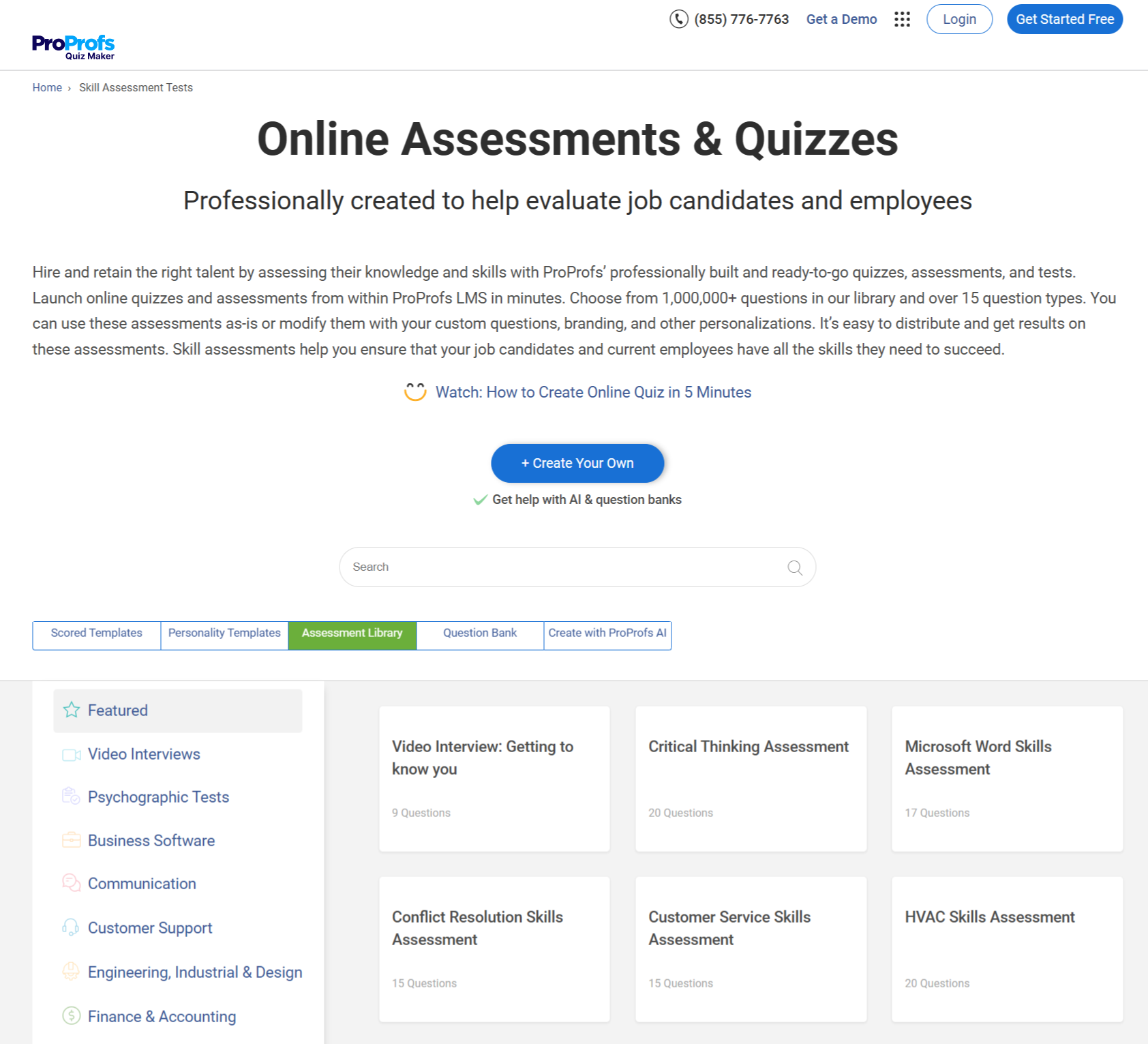
Looking for an even faster way? An AI quiz maker can generate effective questions instantly. Simply enter a topic, set some guidelines, or upload a document, and with a single click, you’ll have a full set of questions—no manual effort required.
If you already have your questions ready, starting from scratch is the way to go. You can manually enter questions or upload them all at once to your online exam maker using an Excel or Doc file, saving time and effort.
Step 2: Add Questions
Adding or building questions is probably the most difficult part of creating a quiz or an exam.
You may have brainstormed for hours and couldn’t come up with the perfect questions. To avoid this, go to the question library and search for your topic or generate the questions you need instantly with AI.
Choose the most relevant questions and add them to your exam. Also, there are multiple question types that you can play around with. You can create a multiple-choice test or throw in a mix of question formats to make your exam engaging.
Step 3: Automate Grading
Manually grading exams can be time-consuming, but with online exam makers, you can set up automated scoring while creating your test. Here’s how to do it:
- Assign Points to Correct Answers – As you add questions, specify how many points each correct answer should be worth. The system will then calculate scores automatically when the exam is submitted.
- Enable Partial Scoring (If Needed) – Allow learners to earn some credit for partially correct answers instead of losing all marks.
- Use Custom Scoring for More Control – Assign different positive or negative point values to specific answer choices to reflect the importance of each option.
- Turn On Negative Marking (If Required) – Deduct points for incorrect answers to discourage guessing and ensure more accurate results.
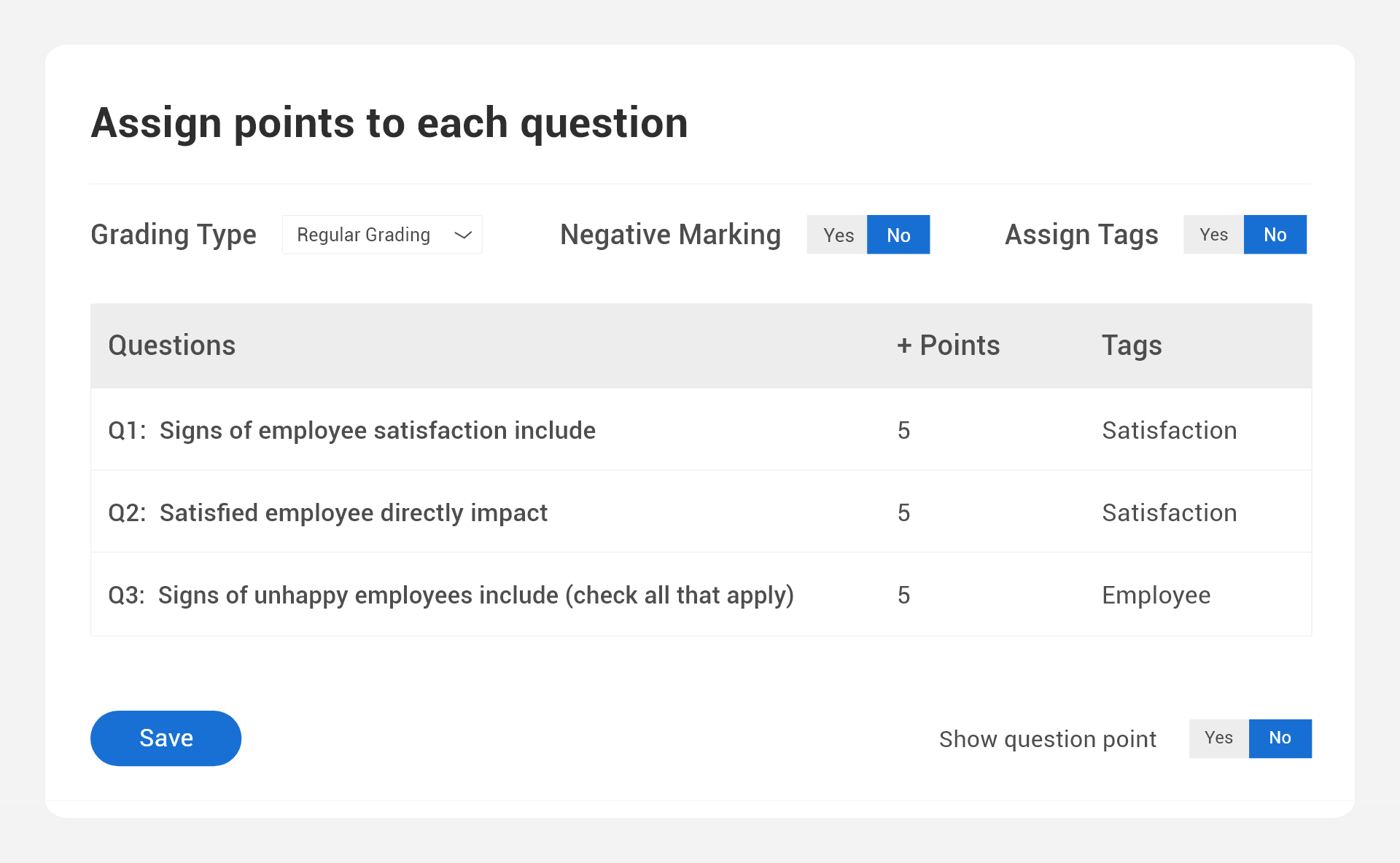
Step 4: Configure Settings
Online exam maker platforms come with a variety of settings that help you secure your test, streamline the experience, and control how results are handled. For instance, here are some of the settings you can configure with ProProfs Quiz Maker:
- Restrict Access: Add password protection to ensure only authorized users can take the exam.
- Enable Anti-Cheating Measures: Activate proctoring, question and answer shuffling, tab-switching prevention, and time limits to reduce the chances of cheating.
- Set Up Automated Notifications: Send alerts to exam takers and other stakeholders (such as instructors or managers) about exam submissions and results.
- Control Result Visibility: Choose whether to show scores immediately or after manual review, and decide what details to display.
- Customize the Results Page: Include feedback, explanations, or additional resources based on learner performance.
- Adjust Exam Layout: Choose whether to display all questions at once or one per page and decide if learners can review and change answers before submitting.
- Schedule Exam Availability: Set specific start and end dates and times to control when the exam can be accessed.
Watch this short video to learn how to configure exam setting:
Step 5: Customize the Look & Feel
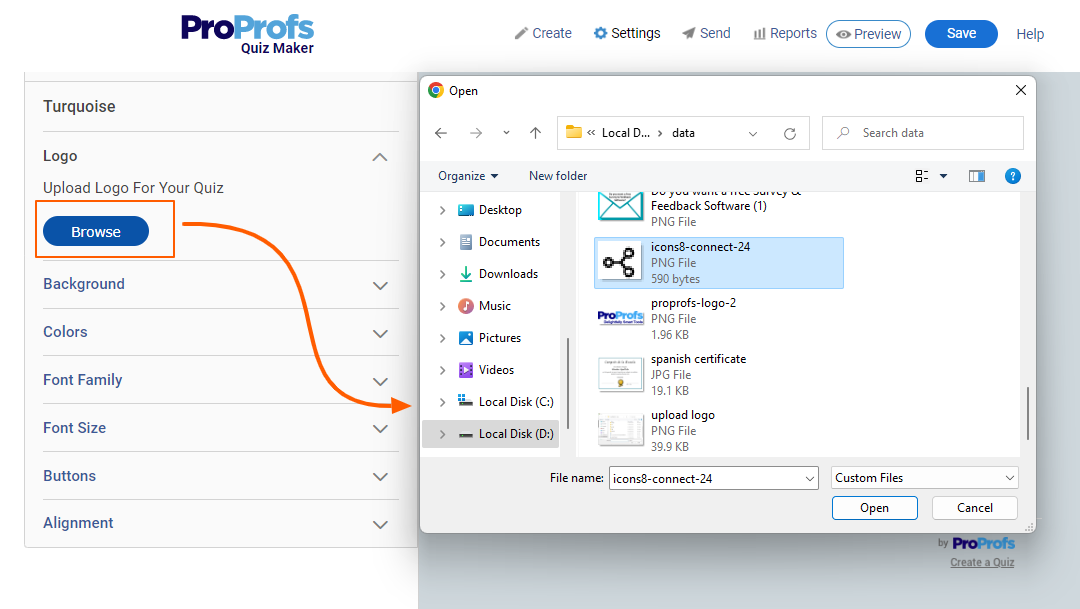
Online exam makers allow you to personalize your exams to make them more engaging and aligned with your brand or learning environment. You can:
- Add your logo to give exams a professional touch.
- Customize backgrounds and themes to match your organization’s style.
- Incorporate images, videos, and documents to enhance questions and provide additional context.
With these customization options, you can create exams that look polished, feel interactive, and keep learners engaged throughout the assessment.
And that’s it! Your online exam is ready to be shared with your learners. Here’s how to do it:
Assigning an Exam to Learners
Once you’re done creating an online examination test, it’s time to assign it to the learners. You can either share the exam with learners via email or assign it to them in an online classroom. You can even embed the exam on your website and control the time window when it’s available.
Watch: How to Share Your Exam With Learners
Setting Up Your Completion Certificates
Everyone loves recognition—especially when it comes in the form of a certificate. While optional for some assessments, certificates are essential for certification exams or any learning experience that benefits from a sense of accomplishment.
With an online exam maker like ProProfs, you can issue branded certificates automatically. Add your logo and choose which fields (name, score, date, etc.) to include. Once a learner completes the exam, their personalized certificate is instantly generated and ready to download.
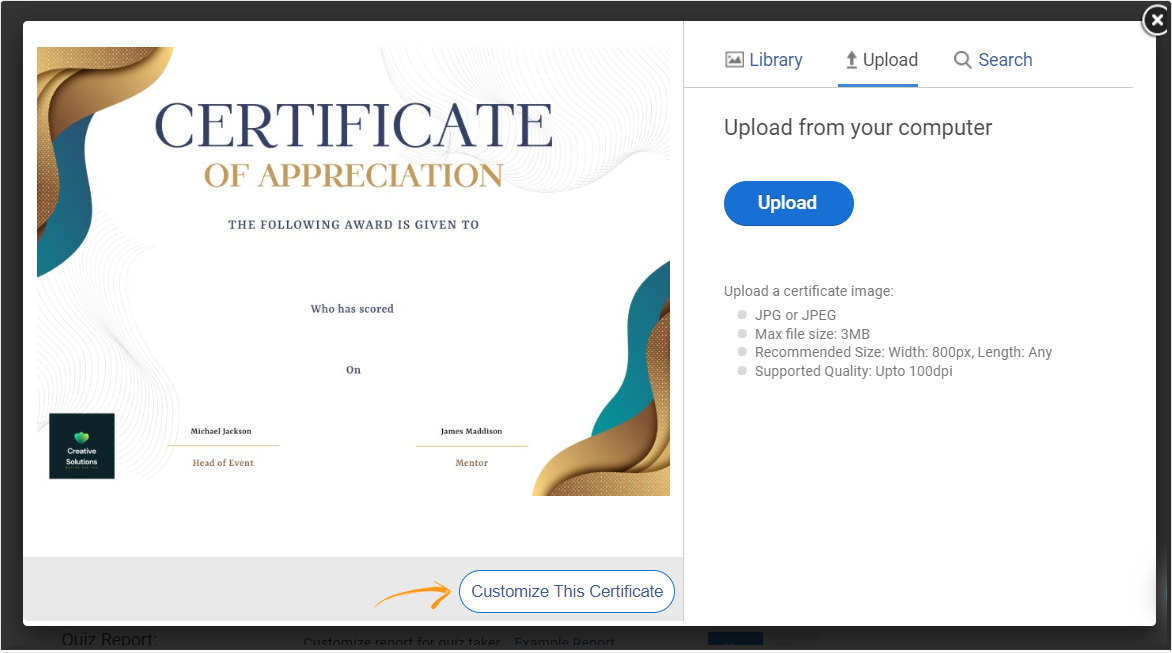
But certificates aren’t just for classrooms.
They can also support professional training, credentialing, and even IP licensing.
Watch the video below to see how Aaron Wimple uses online exams to certify learners on his intellectual property—with ease and automation.
;
You now know how to create an online exam—but to ensure it’s effective, reliable, and learner-friendly, there are some best practices you can follow.
Must-Know Tips for Creating an Effective Online Exam
Creating an online exam can be tricky, but the right approach makes it easier. Here are some tips to help you create the perfect exam:
1. Keep Your Learners in Mind
| What are learners supposed to do after learning the course? Figure that out and build the appropriate interactive elements in the course.
– Tom Kuhlmann, eLearning expert |
Always start with the end goal in mind: what do you want your learners to achieve after completing the course? Understand their needs and tailor your exam to fit that.
For example, if you’re creating an exam for students, focus on questions related to the course material and their knowledge. If the exam is for employees, consider including job-specific questions or tests of their relevant skills and abilities.
By aligning the exam with your learners’ goals, you’ll create a more meaningful and effective assessment.
Examples Across Learning Environments:
Online exam makers are used in diverse contexts—each with different priorities. Here are a few quick examples:
- K–12 Teachers: Use online exams for weekly reading comprehension checks, vocabulary tests, or end-of-unit assessments with visual aids for younger learners.
- Higher Education: Professors can create open-book, timed essay exams or scenario-based MCQs for courses like psychology, economics, or computer science.
- Corporate Trainers: HR or L&D teams can assess employee skills with role-based quizzes during onboarding, compliance training, or leadership development programs.
- Certification Providers: Use secure, proctored exams to test subject mastery in fields like IT, finance, healthcare, or legal compliance—with automatic certificate issuance.
2. Secure Your Exam

After putting effort into creating your exam, the last thing you want is unauthorized access or security breaches. Keeping your exam secure ensures that only the right test-takers can access it while preventing leaks and cheating.
Here’s how you can strengthen exam security:
- Password Protection & Private Links
Protect your exam with a password and share a private link only with authorized learners. This prevents unintended users from accessing the test.
- Unique Login Credentials & Single Sign-On (SSO)
Require test-takers to log in with unique credentials or enable Single Sign-On (SSO) to streamline authentication while ensuring only approved participants can enter the exam.
- Restrict Access by IP
Only allow access to the exam from approved IP addresses or networks. This helps make sure students are taking the test from a designated location and not getting outside help.
- Virtual Classroom Access Control
With ProProfs Quiz Maker, you can assign exams within a virtual classroom where learners must be enrolled to take the test. This ensures that only registered students or employees can participate, eliminating unauthorized access.
By implementing these security measures, you can protect your exam’s integrity, ensure only the right learners take the test, and create a controlled, cheating-free environment.
3. Leverage Anti-Cheating Features
Cheating can be a challenge in online exams, especially without in-person supervision. Fortunately, today’s online exam maker tools offer effective features to detect and prevent cheating in online exams.
- Enable Proctoring
Online proctoring tools help monitor test-takers through webcam, microphone, and screen activity. Proctoring can be live, with a human invigilator watching in real time, or recorded, where the session is captured and later reviewed—either manually by an exam administrator or automatically using AI.
Recorded proctoring automates the process and can flag suspicious behavior such as an attempt to switch tabs, multiple faces, prolonged eye movement away from the screen, or unusual audio cues.
- Create a Question Pool
Instead of giving every test-taker the same set of questions, build a large question bank and have the system randomly pull different ones for each person. This makes it much harder to share answers.
- Randomize Questions and Answer Choices
Shuffling the order of questions and answer options keeps students from receiving identical exams, making it tricky to collaborate or memorize answer sequences.
- Enable Browser Lockdown
Prevent test-takers from switching tabs, copying content, or accessing unauthorized resources during the exam. This not only discourages cheating but also helps protect your exam content from being leaked or shared.
- Control Exam Availability
Make the exam available only within a specific date and time window to ensure all test-takers attempt it under the same conditions. This prevents early access to questions and stops late submissions.
- Set Time Limits
Giving learners a fixed time to complete their exams means they have to rely on their knowledge, not the internet. The key is setting a limit that allows them to think but not enough time to look up every answer.
- Design Questions That Resist AI Cheating
Today’s test-takers can access tools like ChatGPT, making it important to craft questions that require reasoning, application, or analysis—things AI can’t easily answer. Use scenario-based, image-anchored, or multimedia questions to reduce dependence on generative AI tools.
Watch: How to Add a Timer to Your Exam
Bonus: To help you apply these exam security strategies, here’s a comprehensive checklist. It covers key measures before, during, and after the exam to keep your assessments secure and fair.
4. Manage Exam Reattempts
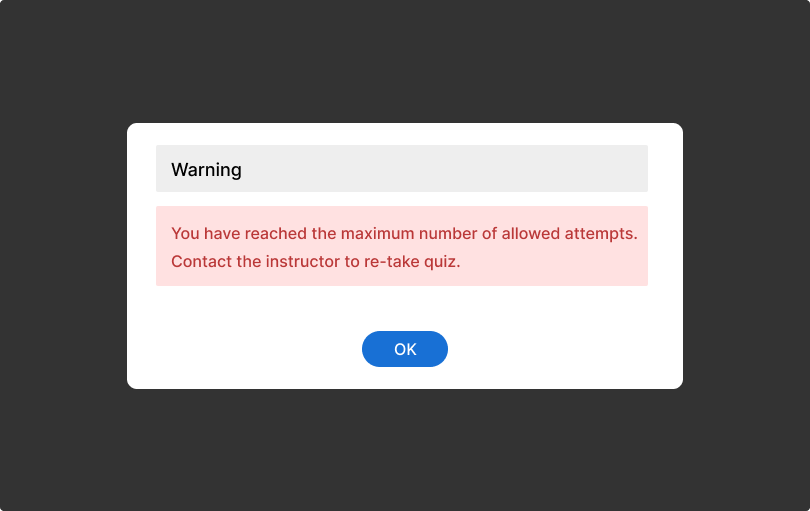
Not every exam should be a one-time shot. But if reattempts are allowed, they should be carefully controlled to maintain fairness and accuracy.
- Set Limits on Reattempts
Decide how many times a test-taker can retake the exam. Whether you allow one retry or multiple attempts, limiting the number prevents unlimited guessing.
- Delay Reattempt Access
Give learners a break between attempts—24 to 48 hours works well. It gives them time to review what they got wrong, prepare better, and come back with a fresh mind instead of just guessing their way through.
- Automatically Provide a Different Exam on Reattempt
If the online exam maker system pulls questions randomly from a large question bank, reattempts will feel like completely new exams. This prevents students from memorizing answers from previous attempts.
By managing reattempts effectively, you can balance fairness while ensuring each attempt truly reflects the test-taker’s knowledge.
5. Use Templates
If you choose not to use templates, creating your exam will likely take more time and effort. Many of the best online exam makers offer ready-to-use templates that are professionally designed, reducing the chances of errors and saving you valuable time.
How? These templates come with pre-assigned points for questions and configured settings, so you can jump right into customizing without worrying about the details.
6. Mix up Question Types
A well-structured exam should include a mix of question types to keep learners engaged and assess different skills effectively. Incorporating multiple-choice, checkboxes, true/false, fill-in-the-blanks, matching, and essay-type questions ensures a balanced evaluation.
For straightforward knowledge checks, multiple-choice and true/false questions work well. Checkbox questions allow test-takers to select multiple correct answers, making them great for assessing broader understanding.
Fill-in-the-blanks and matching exercises test recall and comprehension, while essay-type questions enable in-depth responses that evaluate critical thinking. To make exams more interactive, drag & drop and hotspot questions can visually test learners’ understanding.
A combination of these formats keeps the exam challenging yet engaging while providing deeper insights into learners’ knowledge and problem-solving abilities.
7. Add Instant Feedback

Providing instant feedback through an online exam maker enhances the learning experience by helping test-takers understand their mistakes immediately. Instead of manually reviewing each response, you can configure feedback settings to display explanations right after a question is answered.
You can choose from different types of feedback:
- Single feedback for all answers – A general remark regardless of correctness.
- Feedback for each answer option – Explain why a particular answer is right or wrong.
- Feedback for correct and incorrect answers – Offer specific explanations based on responses.

Instant feedback not only saves time but also reinforces learning, making the exam more effective and insightful for participants.
💡Case Study:
Check out how adding reference information in the feedback helps Nebraska’s Health Department conduct online tests for students in a way that supports their learning.

8. Make Your Exam Engaging

An engaging exam keeps learners focused and improves knowledge retention. A dull, text-heavy test can lead to disengagement, guesswork, and lower performance. By incorporating multimedia elements, you can make assessments more interactive and immersive.
Here’s how you can enhance engagement:
- Add images or videos to questions or answer options to provide context or visual cues.
- Include audio or video clips in questions to assess listening comprehension or practical skills.
- Use interactive elements like drag & drop and hotspot questions to make assessments more dynamic.
A visually rich and interactive exam not only holds attention but also ensures a more effective evaluation of real-world skills.
9. Reduce Exam Anxiety With Smart Layouts
A well-designed exam layout can ease nerves and help learners stay focused. Here’s how to create a calmer test-taking experience:
- One question per page – Helps learners concentrate on one task at a time, reducing information overload.
- Progress bar – Shows how much of the exam is left, which boosts confidence and pacing.
- Review before submission – Let learners revisit and edit their answers, giving them a sense of control and reducing second-guessing.
These small tweaks in your online exam maker’s settings make your exam less intimidating and more learner-friendly—especially for high-stakes assessments.
10. Run a Practice Test Before the Real Exam
Tech issues and unfamiliar layouts can rattle even the most prepared learners. Assigning a quick practice test helps them get comfortable with the platform, check their devices, and avoid last-minute surprises.
- Test device compatibility – Ensure everything works smoothly across browsers, devices, and internet connections.
- Familiarize with the layout – Let learners experience the one-question-per-page format, navigation, and timer in advance.
- Lower test anxiety – Practicing in a risk-free environment builds confidence before the real thing.
What Are the Benefits of Using an Online Exam Maker?
Online exam software allows for precise assessment of learners’ knowledge while streamlining the teaching process. Here are the key benefits you can gain from using it:
1. Create and Share Exams Anytime, Anywhere
The best thing about using an online exam creator is the freedom to create and share exams from any place at any time while also ensuring convenience for learners. You could be traveling, at home resting, or even relaxing on vacation far from your workplace and still be able to assign exams effortlessly.
Since the online exam creator is cloud-based, learners can access and take the exam anytime, anywhere, using their preferred device. No printing, no manual distribution, and no logistical headaches—just a smooth, hassle-free testing experience for both you and your test-takers.
That flexibility really came through for educators like Kevin Tole, a driver’s ed teacher who turned his home into a virtual classroom during the pandemic.
Here’s how ProProfs helped him keep teaching without missing a beat:
2. Build an Exam in Minutes (or Even Seconds!)
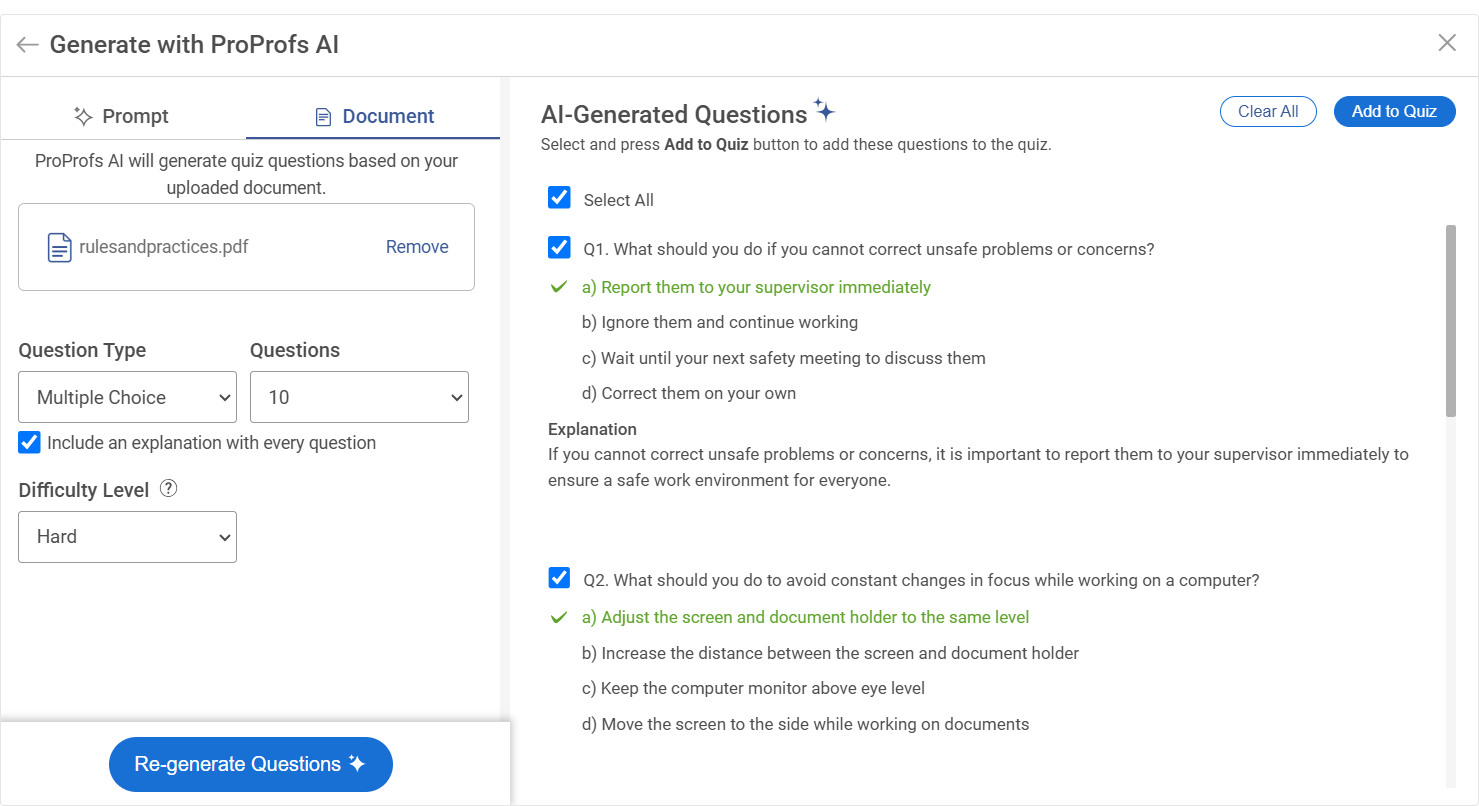
Imagine this—you’re pressed for time, and your online exam needs to go live tomorrow. Manually drafting questions from scratch can feel overwhelming. But with the right tools, you don’t have to start from zero.
Instead of spending hours creating questions, you can use pre-designed templates or pull from a question library to quickly assemble your exam. Even better, AI-powered quiz generation takes things to the next level. Simply provide a topic, difficulty level, and guidelines, or upload a document, and the online exam maker will generate a complete exam with diverse question formats in seconds.
With these time-saving features, you can create a professional, well-structured exam without the last-minute scramble—all while ensuring quality and relevance.
3. Save Hours on Grading & Give Learners Instant Clarity
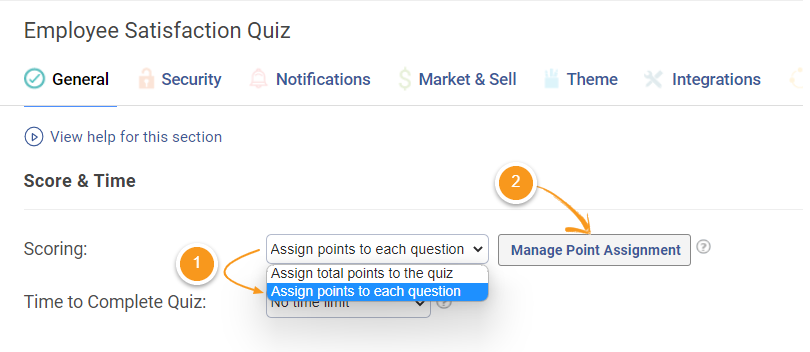
Grading exams is one of the most time-consuming and exhausting tasks for educators and trainers. Spending hours manually checking answers, assigning scores, and writing feedback can quickly become overwhelming—especially with large groups of learners.
With an online exam maker, you can automate the grading and feedback process. That means no more late nights spent marking papers or double-checking scores—everything is done for you in seconds. You can focus on what really matters—teaching and mentoring.
Even better, learners don’t have to wait for their results. Instant feedback explains mistakes on the spot, reinforcing learning while it’s still fresh.
4. Ask Questions in Interactive & Multimedia Formats

Online exam makers unlock question formats that go beyond what’s possible in traditional paper-based tests, making assessments more engaging and effective. With the ability to embed videos and audio clips, you can assess skills that a standard written exam simply can’t measure.
For example, video-based questions allow learners to watch a short clip and respond with insights, perfect for subjects like media studies, healthcare training, or language assessments. Audio/video-response questions enable learners to record spoken answers, making it possible to evaluate pronunciation, verbal reasoning, and communication skills.
This isn’t just a cool feature—it’s transforming how teachers assess deeper thinking.
Take Glenn Wilkinson, a film studies teacher in Northern Ireland and a delighted ProProfs customer. He embeds short movie clips into his online quizzes and asks students to analyze how the director tells the story using detailed film language.
Watch the video below to hear more about his experience:
5. Get Actionable Insights With Detailed Reports
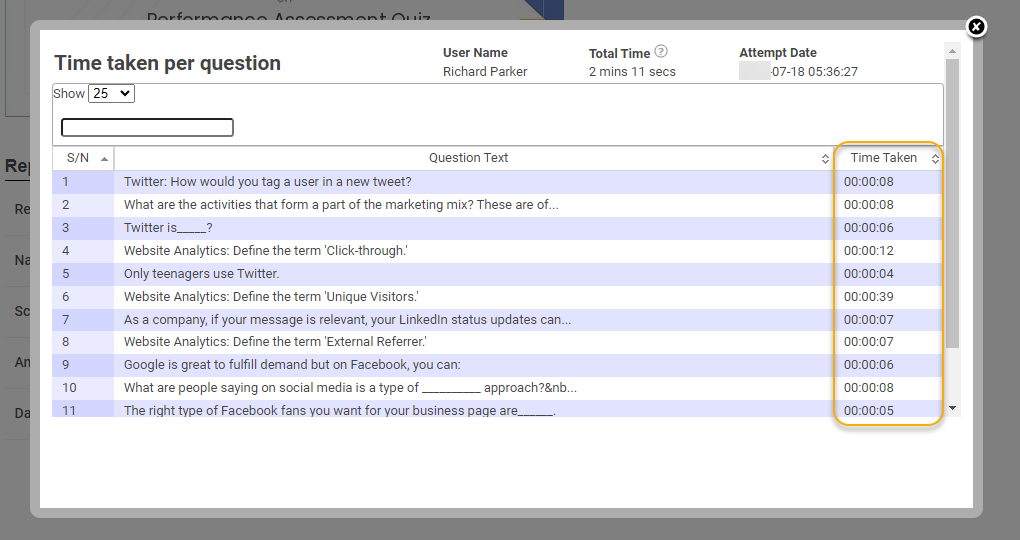
Online exam makers provide more than just a pass-or-fail outcome—they generate detailed reports that help educators and trainers measure performance more effectively. Instead of manually reviewing each test, reporting tools compile data automatically, offering insights that can improve assessments and learning strategies.
Key benefits of online exam reporting include:
-
- Track Individual and Group Progress – Monitor how each learner performs over time or compare results across different groups to identify trends.
- Compare Performance Across Cohorts – Analyze differences in scores between classes, training batches, or departments to assess overall learning effectiveness.
- Identify Knowledge Gaps – Spot which topics or questions learners struggle with the most, allowing for targeted improvements.
- Monitor Time Usage – See how long test-takers spend on each question and the overall exam to detect pacing issues.
- Analyze Question Effectiveness – Determine whether certain questions are too easy, too difficult, or unclear based on response patterns.
- Download and Share Reports – Export performance data in various formats for further analysis or record-keeping. Share reports automatically with all stakeholders.
- SCORM/Tin Can & API – Send detailed reports and data on learners’ interactions with your content to your learning record store (LRS) or server for seamless tracking and analysis.
Watch: How to Review Online Exam Reports & Statistics
6. Easily Track & Manage Exam Transcripts
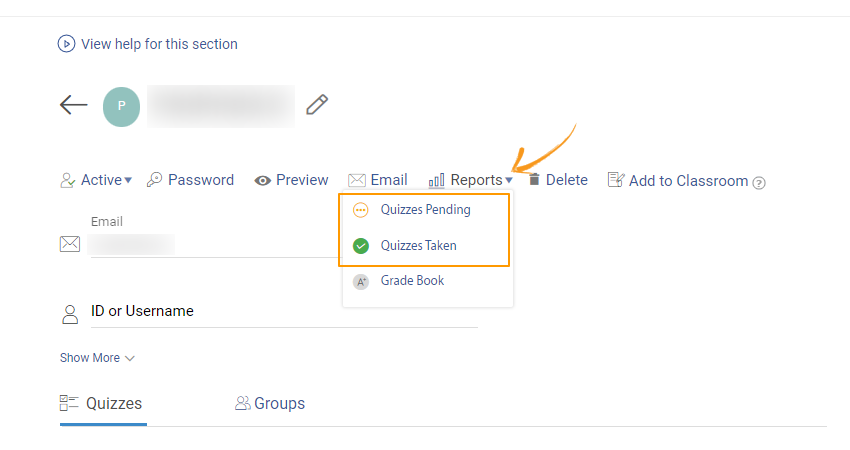
Keeping track of exam results manually can be a nightmare—lost papers, endless spreadsheets, and the constant struggle to find past records when you need them. Online exam makers eliminate the hassle by automatically storing and organizing all results in one secure place.
With digital record-keeping, you can:
- Ditch the paperwork – No more filing cabinets or scattered documents. Every exam result is stored safely online.
- Instantly access past records – Need to check a student’s performance from last year? Just a few clicks, and you can pull up their grade book.
- Track long-term progress effortlessly – See how learners improve over multiple assessments without digging through old reports.
- Export transcripts anytime – Whether it’s for evaluations, certifications, or compliance, you can generate reports in seconds.
FREE. All Features. FOREVER!
Try our Forever FREE account with all premium features!
Create Smarter, Scalable Exams That Run on Autopilot
Online exam makers aren’t just about going digital—they’re about doing less and achieving more. With the right tool, you can build secure, scalable, and stress-free exams that empower both you and your learners.
If you’re ready to modernize how you test knowledge—whether for students, employees, or certification seekers—online exams offer a smarter alternative to outdated methods. With automated grading, interactive question formats, and built-in security, you’ll cut hours of busywork while gaining clear insights into learner performance.
ProProfs Quiz Maker helps you build a streamlined, repeatable system for creating and managing exams at scale. As your course load or organization grows, it adapts with you—so you can focus on delivering value, not handling logistics.
Frequently Asked Questions
What are some free online exam maker tools?
Here are the two most popular options:
- ProProfs Quiz Maker - Offers a forever free plan with AI quiz generation, auto-grading, 20+ question types, customizable templates, and analytics. It’s ideal for short quizzes and assessments.
- Google Forms - A simple tool for creating quizzes with multiple question types and automated scoring, plus easy result tracking via Google Sheets.
How do you create a proctored exam?
A proctored exam monitors students to prevent cheating. To create one:
- Use proctoring-enabled online exam makers like ProProfs, ExamSoft, or Respondus.
- Create your exam by adding questions and answer options.
- Enable webcam and screen-sharing options to monitor test-takers.
- Set up anti-cheating features like question shuffling, tab switching prevention, and copy-paste restrictions.
- Provide clear guidelines for students on test rules and monitoring.
How do I create a certification exam?
Follow these steps to create a certification exam with an online exam maker:
- Define the competencies and knowledge areas to be tested.
- Create a mix of question types to assess different skills.
- Use an online exam maker with automated grading and tracking to create your exam.
- Set a passing score and enable certification issuance upon completion.
- Customize certificates with your logo, recipient details, and issue date.
 Tips
Tips
We’d love to hear your tips & suggestions on this article!
FREE. All Features. FOREVER!
Try our Forever FREE account with all premium features!

 We'd love your feedback!
We'd love your feedback! Thanks for your feedback!
Thanks for your feedback!






